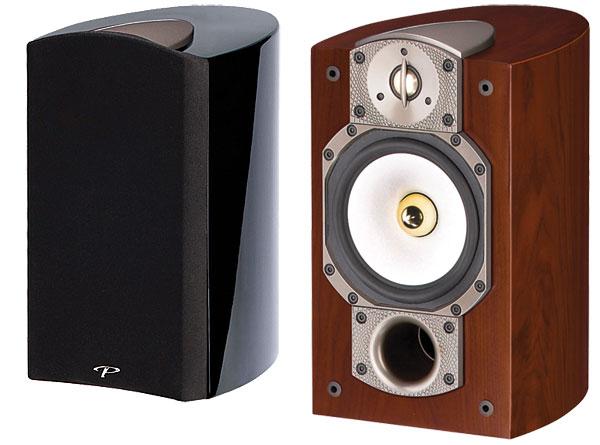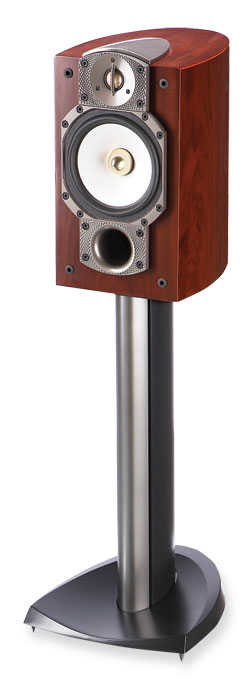| Columns Retired Columns & Blogs |
Love these lil buggers.

The two-way, front-ported Reference Studio 20 v5 is the second from the bottom of the four-model, midpriced Reference Studio series. It's not meaningful to detail the differences between the v5 and v4—the 1", ferrofluid-damped and -cooled dome tweeter remains the same, but the v5's mid/woofer and cabinet are new. The new drive-unit is a 7" cone with an elliptically profiled surround of Santoprene artificial rubber, designed to achieve lower distortion, and deeper, louder bass. The curved cabinet—its footprint resembles the heel of a man's shoe—is intended to minimize the internal sound reflections and edge diffraction that plague rectangular cabinet interiors. The enclosure of braced MDF is treated with Permacote Linacoustic to damp internal cabinet resonances and vibrations.
The Reference Studio 20 costs $1398/pair in one of its two standard finishes, Cherry or Rosenut; the Piano Black (add $100/pair) of my review samples was striking yet understated, and blended well with my room's décor. Paradigm also supplied their J29 stands ($498/pair; their standard S30 stand costs $150/pair), made of heavy-duty steel and extruded aluminum, with adjustable spikes and a channel through which to route cables. What I liked best about the J29s was being able to secure the speakers to them with Allen bolts, to improve rigidity.
 Paradigm used to strongly encourage leaving the 20's grille in place—they'd voiced the speaker for maximum neutrality with its grille on. For the Studio 20 v5 they've redesigned the grille, and now claim that the speaker is equally neutral and transparent with the grille on or off. I preferred the sound with the grilles; the integration of the midrange and bass seemed more coherent. I was glad—I find the speakers quite sexy with their grilles on, butt-ugly when naked.
Paradigm used to strongly encourage leaving the 20's grille in place—they'd voiced the speaker for maximum neutrality with its grille on. For the Studio 20 v5 they've redesigned the grille, and now claim that the speaker is equally neutral and transparent with the grille on or off. I preferred the sound with the grilles; the integration of the midrange and bass seemed more coherent. I was glad—I find the speakers quite sexy with their grilles on, butt-ugly when naked.
Listening
I listened to the Studio 20s for several months before I could come close to verbalizing what made it sound so special. Its greatest strengths were in three areas:
Resolution of Inner Detail: The Studio 20 had an uncanny ability to unravel layers and layers of detail—it was very easy to listen to a familiar recording and hear things for the first time. Moreover, the speaker's reproduction of room ambience and decay meant that the best recordings had a better sense of live musicians playing in a real room than I've heard from many other speakers.
Harmonic Integrity in the Mid- and High Frequencies: Although I heard no trace of coloration in the Studio 20's mids and highs, its strengths went beyond that. With instruments that have large amounts of both mid- and high-frequency energy, there was a certain rightness to the sound; the ratio of fundamental frequencies to harmonics was so well balanced that it portrayed a degree of verisimilitude unusual for a speaker costing only $1398/pair.
Dynamic Realism: Not only did the Studio 20 produce a high level of dynamic realism with the most demanding recordings, even at high volumes in a very large room, but its low-level dynamics were equally impressive. Of course, the speaker reproduced the dynamic range from ppp to p region in a natural fashion, but I seemed to hear several levels of dynamic gradation between, say, ppp and pp.
I heard several things in the Beatles' Beatles for Sale (CD, Parlophone PMC 1240) that I hadn't noticed before. I found myself analyzing the dynamic phrasing of the timpani in the choruses of "Every Little Thing," and in "What You're Doing," the decay of Ringo's floor tom was so clearly delineated that I could almost tell how far he'd tightened his skins. The word decay appeared more often in my listening notes with this speaker than with any other. In "The Beach," from Bill Frisell's In Line (CD, ECM 1241), I noted the exceptionally long decays of the guitarist's delicate and airily chiming upper-register figures. Lower in register, the vibrant warm midrange of Paul Bley's piano, and his delicate but deliberate phrasing in "Memories," from Bley's Fragments (CD, ECM 1520), were showcased.
John Cage's works for piano typically use a lot of silence. In Josef Christof's reading of One, from Late Piano Works (CD, ITM 950031), long sustained chords and single notes punctuated by long silences. Through the Paradigms, the decay of each note was clear as it blended perfectly with the recorded acoustic. The speakers mated well with all piano recordings—I was captivated by the interplay of Gary Peacock's rich, woody double bass and Marilyn Crispell's warm, delicate, silky piano in the title track of her Amaryllis (CD, ECM 1742). All well-recorded voices shone as well—such as Norah Jones's in Joni Mitchell's "Court and Spark," from Herbie Hancock's River: The Joni Letters (CD, Verve B0009791-02)—her slight chestiness was as rich and silky as Crispell's piano.
Mitchell's own recordings illustrated the Paradigm's ability to render extended and detailed highs without a trace of harshness. The extended and natural harmonics of her Martin flattop guitar in "Urge for Going," from Hits (CD, Reprise 46326-2), were pristine and clear but without becoming jangly. Mariuk Deiju's violin in his recording of Paganini's 24 Caprices for Solo Violin (CD, JVC JVCC-6504-2) seemed to have "infinitely extended harmonics," per my notes, with the requisite bite but with no loss of the instrument's natural sweetness. The Studio 20's reproduction of High-frequency percussion sound also impressed me. Kenny Wollenson's vibes solo in "Have Yourself a Merry Little Christmas," from John Zorn's A Dreamers Christmas (CD, Tzadik 7393), had a bell-like chiming sound, with delicate, airy, shimmering decays.


For over two years I've been enjoying this speaker. Very happy to see them get some priase in a publication like this one. HUGE difference over the v.4 as stated in the review (which wasn't a bad desing in it's own right). Great all-around speaker especially if matched with good electronics.

Got a pair a few months ago for my third system . I had it narrowed down to three pair but thanks to Bobs great review I went with the Paradigm's . Thanks Bob .
After listening to them for a few months then rereading the review I can confirm that Bobs sonic description was accurate .
I tried them with quite a few amps before settling on a 200 watt Luxman that I retired a bunch of years ago . At first I felt that the 20's were not capable of playing loud and clean but once I had them properly driven that was not a concern . Also tried a bunch of speaker cables before being content with Cardas's new Clear cable . Great match .
Tim

Until you own one, you can't imagine how heavy they are. They also deserve a very good amplifier, although I drive mine with a Marantz. I must admit that some of Canton's new stand mounts give an airier sound, the Studio 20 gives a presence that few other speakers of this size can.